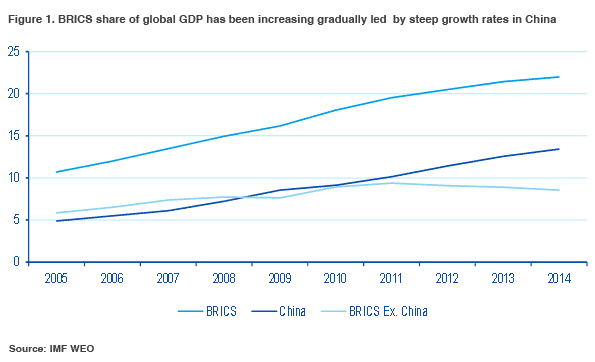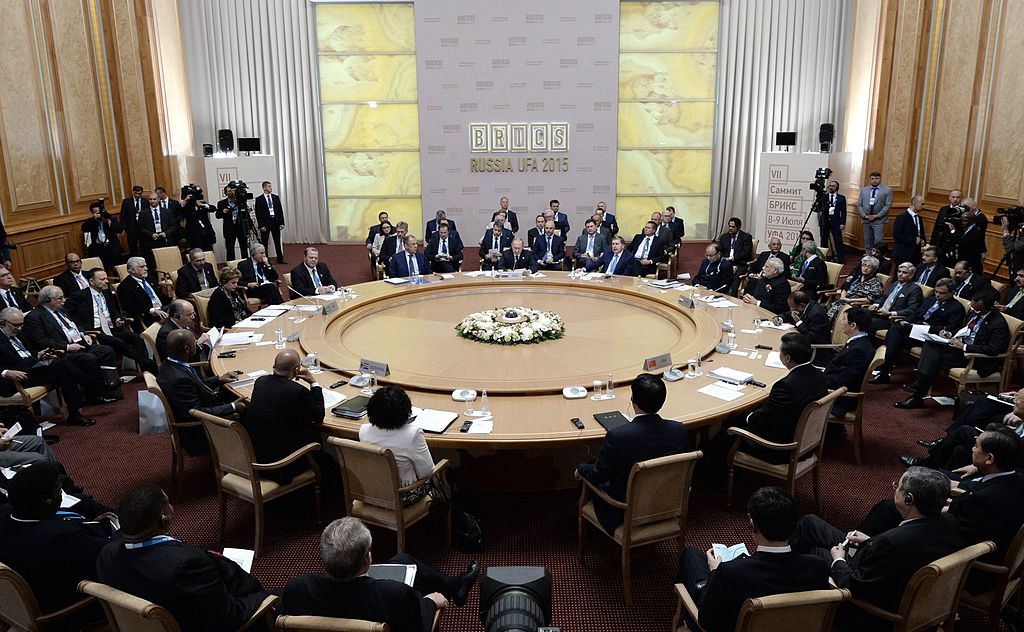The BRICS have just held their annual summit in Ufa, Russia, amid looming concerns of financial turmoil in China, Europe and beyond. While not much has come out of the meeting, the differences between its members have been evident, signalling a shift in the bloc’s future dynamics.
On a happier note, the BRICS remain highly relevant. They still account for 42% of the world’s population and 26% of its surface. Furthermore, their share of global GDP has continued to increase, although at a very gradual rate, and now accounts for 22% of global GDP (according to IMF WEO figures see Figure 1). While this is encouraging, the increase has primarily been due to the steep growth rates in China –since the share of the BRICS’ GDP excluding China has actually fallen–, which, in any case, are a far cry from what the BRICS could have otherwise delivered.

Why haven’t the BRICS delivered?
As well as a global financial crisis of unprecedented depth and length, the BRICS have started to face mounting domestic pressures. Brazil is struggling with a recession, while Russia is grappling with crippling sanctions. South Africa lags behind in terms of basic infrastructure (power cuts are a major constraint on growth) while China is struggling to portray itself as a consumer-led market economy. According to Chen Yun’s ‘bird-cage’ theory of the post-Great Leap economic recovery, whereby the bird represents the free market and the cage represents a central plan, served as the basis for Deng’s ‘opening and reform’ agenda. Someone should coin the term ‘prison-break’ to describe the economic reform process under Xi Jingping. Perhaps the most conspicuous sliver of hope comes from India. It is now growing at a faster rate than China, although from a much lower base. Furthermore, most high-frequency domestic activity indicators such as credit growth, IP, freight traffic and vehicle sales, remain subdued while first quarter corporate earnings have been disappointing.
Another important topic is the fact that the BRICS’ growth prospects have been affected by the slowdown of China’s economy. It should not be forgotten that China is already a leading, if not the main, trade partner of the BRICS. During the good times, China’s thirst for commodities helped to fuel a commodity supercycle which favoured the BRICS’ exports. Global commodities prices have slumped this year, partly as a reflection of slowing economic growth in China, the world’s largest consumer of metals, oil and grains. For the less forward-looking BRICS, adapting to a ‘new normality’ of lower commodity prices –Brazil springs to mind–, it will not be easy as they have not built up fiscal and external buffers to cope with poorer trade terms.
The BRICS move towards a new world order
The differences between BRICS have never been more apparent. In addition to being at different stages of economic development, they have also become increasingly fragmented politically. Brazil, India and South Africa are emerging democracies that promote the rule of law and western-style governance structures, while China and Russia are autocratic. But the divisions do not stop there. While all countries have vested interests in maintaining good relations with Russia, China has become increasingly contentious. A good example of this is its decision to abstain (but not veto) the UN Security Council’s vote on the Ukraine.
When it comes to challenging the existing world order, the BRICS have advanced considerably as a bloc. Not content with the ‘Atlanticism’ of the Bretton Woods institutions, the BRICS have implemented a number of institutions that serve as a counterbalance but are intended promote more closely the emerging world’s common development goals. The most obvious example is the Shanghai Cooperation Organisation (SCO), established in 1996 to prevent conflicts that would enable the US or NATO to intervene in areas bordering Russia and China. India and Pakistan are now considering joining the SCO and, while this was not confirmed at the BRICS summit, the meetings did pave the way for this to take place in six months’ time as China seeks to play a bigger role as a peace-keeper in the region.
Similarly, the BRICS’ New Development Bank (NDB), established last year in Brazil but launched right before the BRICS’ Summit in Ufa, will start its first batch of infrastructure projects in April 2016. The NDB, with an initial capital of US$100 billion, was established as an alternative to the IMF, after the BRICS were frustrated by stalled efforts to increase the emerging markets’ representation. Yet again, the differences between China and the other BRICS also became apparent, with Beijing’s (to some extent more successful) launch of the Asian Infrastructure Investment Bank (AIIB) only months after the NDB’s announcement. All the BRICS are also founding members of the AIIB.
Looking forwards: greater cooperation to overcome the obstacles to growth
While initiatives that promote infrastructure investments are a good start, it is unlikely that they will alone be enough to offset the mounting obstacles to growth stemming from weak global demand and China’s economic slowdown. First of all, it remains to be seen whether these initiatives can actually deliver noticeable results. Secondly, in order for investments to yield benefits, they need to be implemented in ways that are cost-effective, transparent and independent of political motivations. Thirdly, even if all pledges were to materialise, in which case the pool of money would be similar to the World Bank, the figures are still small in relation to trade flows. While China is an important trade partner, so are the EU and the US.




